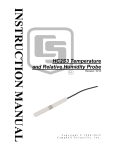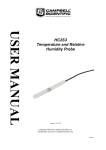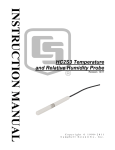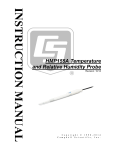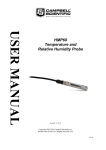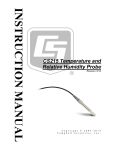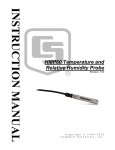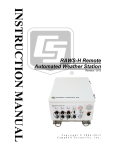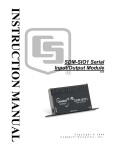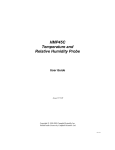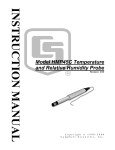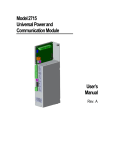Download Campbell HC2S3 User manual
Transcript
HC2S3 Temperature and Relative Humidity Probe User Manual Issued: 12.12.12 Copyright © 2005-2012 Campbell Scientific Inc. Printed under Licence by Campbell Scientific Ltd. CSL 930 Guarantee This equipment is guaranteed against defects in materials and workmanship. This guarantee applies for twelve months from date of delivery. We will repair or replace products which prove to be defective during the guarantee period provided they are returned to us prepaid. The guarantee will not apply to: • Equipment which has been modified or altered in any way without the written permission of Campbell Scientific • Batteries • Any product which has been subjected to misuse, neglect, acts of God or damage in transit. Campbell Scientific will return guaranteed equipment by surface carrier prepaid. Campbell Scientific will not reimburse the claimant for costs incurred in removing and/or reinstalling equipment. This guarantee and the Company’s obligation thereunder is in lieu of all other guarantees, expressed or implied, including those of suitability and fitness for a particular purpose. Campbell Scientific is not liable for consequential damage. Please inform us before returning equipment and obtain a Repair Reference Number whether the repair is under guarantee or not. Please state the faults as clearly as possible, and if the product is out of the guarantee period it should be accompanied by a purchase order. Quotations for repairs can be given on request. It is the policy of Campbell Scientific to protect the health of its employees and provide a safe working environment, in support of this policy a “Declaration of Hazardous Material and Decontamination” form will be issued for completion. When returning equipment, the Repair Reference Number must be clearly marked on the outside of the package. Complete the “Declaration of Hazardous Material and Decontamination” form and ensure a completed copy is returned with your goods. Please note your Repair may not be processed if you do not include a copy of this form and Campbell Scientific Ltd reserves the right to return goods at the customers’ expense. Note that goods sent air freight are subject to Customs clearance fees which Campbell Scientific will charge to customers. In many cases, these charges are greater than the cost of the repair. Campbell Scientific Ltd, Campbell Park, 80 Hathern Road, Shepshed, Loughborough, LE12 9GX, UK Tel: +44 (0) 1509 601141 Fax: +44 (0) 1509 601091 Email: [email protected] www.campbellsci.co.uk PLEASE READ FIRST About this manual Please note that this manual was originally produced by Campbell Scientific Inc. primarily for the North American market. Some spellings, weights and measures may reflect this origin. Some useful conversion factors: Area: 1 in2 (square inch) = 645 mm2 Length: 1 in. (inch) = 25.4 mm 1 ft (foot) = 304.8 mm 1 yard = 0.914 m 1 mile = 1.609 km Mass: 1 oz. (ounce) = 28.35 g 1 lb (pound weight) = 0.454 kg Pressure: 1 psi (lb/in2) = 68.95 mb Volume: 1 UK pint = 568.3 ml 1 UK gallon = 4.546 litres 1 US gallon = 3.785 litres In addition, while most of the information in the manual is correct for all countries, certain information is specific to the North American market and so may not be applicable to European users. Differences include the U.S standard external power supply details where some information (for example the AC transformer input voltage) will not be applicable for British/European use. Please note, however, that when a power supply adapter is ordered it will be suitable for use in your country. Reference to some radio transmitters, digital cell phones and aerials may also not be applicable according to your locality. Some brackets, shields and enclosure options, including wiring, are not sold as standard items in the European market; in some cases alternatives are offered. Details of the alternatives will be covered in separate manuals. Part numbers prefixed with a “#” symbol are special order parts for use with non-EU variants or for special installations. Please quote the full part number with the # when ordering. Recycling information At the end of this product’s life it should not be put in commercial or domestic refuse but sent for recycling. Any batteries contained within the product or used during the products life should be removed from the product and also be sent to an appropriate recycling facility. Campbell Scientific Ltd can advise on the recycling of the equipment and in some cases arrange collection and the correct disposal of it, although charges may apply for some items or territories. For further advice or support, please contact Campbell Scientific Ltd, or your local agent. Campbell Scientific Ltd, Campbell Park, 80 Hathern Road, Shepshed, Loughborough, LE12 9GX, UK Tel: +44 (0) 1509 601141 Fax: +44 (0) 1509 601091 Email: [email protected] www.campbellsci.co.uk Contents PDF viewers: These page numbers refer to the printed version of this document. Use the PDF reader bookmarks tab for links to specific sections. 1. Introduction .................................................................. 1 2. Cautionary Statements................................................ 1 3. Initial Inspection .......................................................... 1 4. Quickstart ..................................................................... 2 5. General Description..................................................... 5 6. Specifications .............................................................. 5 6.1 Temperature Sensor ................................................................................. 6 6.2 Relative Humidity Sensor ........................................................................ 6 6.3 Default Settings and Digital Interface ...................................................... 7 7. Installation .................................................................... 7 7.1 Siting ........................................................................................................ 7 7.2 Assembly and Mounting .......................................................................... 8 8. Wiring ........................................................................... 9 9. Example Programs .................................................... 10 9.1 Example Programs using Single-Ended Measurement Instructions ...... 11 9.2 Example Programs using Differential Measurement Instructions.......... 15 10. Measuring Probes with Long Cables ..................... 17 11. Sensor Maintenance ................................................ 18 12. Troubleshooting ...................................................... 18 13. References ............................................................... 19 i Appendices A. Absolute Humidity................................................... A-1 A.1 Measurement Below 0°C ..................................................................... A-2 B. Changing the HC2S3 Temperature Range ............ B-1 B.1 B.2 B.3 B.4 HC2S3 Default Settings ....................................................................... B-1 Software and Hardware Requirements ................................................ B-1 Changing the Temperature Range ....................................................... B-2 Multiplier and Offsets for Temperature Range .................................... B-3 C. HC2S3 Digital Communications ............................. C-1 C.1 C.2 C.3 C.4 HC2S3 Digital Interface Specifications ............................................... C-1 HC2S3 Communications Protocol ....................................................... C-1 RS-485 Communications using an MD485 RS-485 Interface ............. C-3 RS-485 Communications using an SDM-SIO1 Serial I/O Module ..... C-5 Figures 7-1. HC2S3 and Met20 Radiation Shield on a vertical pole .......................... 8 Tables 8-1. Connections for Single-Ended Measurements ........................................ 9 8-2. Connections for Differential Measurements ......................................... 10 9-1. Temperature .......................................................................................... 11 9-2. Humidity ............................................................................................... 11 9-3. Wiring for Single-ended Measurement Examples ................................ 12 9-4. Wiring for Differential Measurement Examples ................................... 15 A-1. Wiring for Vapour Pressure Examples............................................... A-1 ii HC2S3 Temperature and Relative Humidity Probe 1. Introduction The HC2S3 is a rugged, accurate temperature/RH probe that is ideal for longterm, unattended applications. The probe uses a Rotronic’s IN1 capacitive sensor to measure RH and a 100 ohm PRT to measure temperature. For optimum results, the HC2S3 should be recalibrated annually. Before using the HC2S3, please study • • • Section 2, Cautionary Statements Section 3, Initial Inspection Section 4, Quickstart More details are available in the remaining sections. 2. Cautionary Statements • Care should be taken when opening the shipping package to not damage or cut the cable jacket. If damage to the cable is suspected, consult with a Campbell Scientific applications engineer. • Although the HC2S3 is rugged, it should be handled as a precision scientific instrument. • Do not touch the sensor element. • The black outer jacket of the cable is Santoprene® rubber. This compound was chosen for its resistance to temperature extremes, moisture, and UV degradation. However, this jacket will support combustion in air. It is rated as slow burning when tested according to U.L. 94 H.B. and will pass FMVSS302. Local fire codes may preclude its use inside buildings. 3. Initial Inspection • Upon receipt of the HC2S3, inspect the packaging and contents for damage. File damage claims with the shipping company. • The model number and cable length are printed on a label at the connection end of the cable. Check this information against the shipping documents to ensure the correct product and cable length are received. • Refer to the Ships With list to ensure that parts are included (see Section 3.1). The HC2S3 probe and its calibration card are shipped in a small box, with the box and PN #27731 Hex Plug attached to the cable. 3.1 Ships With The HC2S3 ships with: (1) Calibration Card (1) Resource DVD/CD 1 HC2S3 Temperature and Relative Humidity Probe 4. Quickstart 4.1 Step 1 — Mount the Probe Review Section 7.2, Installation for complete instructions. The HC2S3 is normally installed by mounting it inside a Met20 shield. 4.2 Step 2 — Use SCWin Short Cut to Program Datalogger and Generate Wiring Diagram The simplest method for programming the datalogger to measure the HC2S3 is to use Campbell Scientific's SCWin Short Cut Program Generator. 2 1. Open Short Cut and click on New Program. 2. Select a datalogger and scan interval. User Manual 3. Select HC2S3 Temperature and Relative Humidity Sensor and choose either constant power or panel switched power (uses less current), then click the right arrow to add it to the list of sensors to be measured. 4. Define the name of the public variables. Variables default to AirTC and RH that hold the air temperature and relative humidity measurements. Select the desired units of measure. Units default to Deg C. 3 HC2S3 Temperature and Relative Humidity Probe 4 5. Choose the outputs for the AirTC and RH and then select finish. 6. Wire according to the wiring diagram generated by SCWin Short Cut. User Manual 5. General Description The HC2S3 is a digital probe with 0 to 1 V linear output signals for temperature and humidity, and a UART serial interface. The voltage signals can be measured with two single-ended or two differential inputs on the datalogger. A special Rotronic cable and the SDM-SIO1 Serial I/O Module or MD485 RS-485 Interface is required to interface with the UART as described in Appendix B. The D/A converter used to generate the analogue output signals has 16-bit resolution. The default configuration is for temperature -40° to +60°C, and 0 - 100% relative humidity. Temperature range and other default settings can be changed as described in Appendix A. A cable ordered through CSI for the HC2S3 includes an internal voltage regulator that applies 3.3 V to the probe from a 5 to 24 V power source. 12V power is recommended for use with CSI dataloggers. Where minimizing power use is important, power can be switched on and off for the measurement provided there is a 3-second warm-up delay. Switching power avoids the constant current flow through datalogger ground, which can affect the accuracy of low level single-ended voltage measurements, primarily with older dataloggers such as the 21X. Probes are polarity protected by the keyed connector and a diode in the connector interface provided with the CSI cable. CSI offers two filters: Polyethylene filter: Default filter, protection against fine dust particles, no water absorption or retention, good response time. Teflon filter: Recommended for marine environments, slower response time than the polyethylene filter, ordered separately. 6. Specifications Operating Limits at Electronics: -40°C to +100°C Storage Temperature: -50°C to +100°C Probe Length: 85 mm (3.3 "), 121 mm (4.75”) including connector Probe Diameter: 15 mm (0.6 ") Probe Weight: 10 g (0.35 oz) Filter: Polyethylene or Teflon (optional, ordered separately) Power Consumption: <4.3 mA @ 5 V <2.0 mA @ 12 V Supply Voltage (using CSI cable): 5 to 24 VDC (12 VDC recommended) Start-up time: 1.5 sec typical (Rotronic specification, CSI recommends 2 sec at 60°C, 3 sec at 0°C, 4 sec at -40°C) Maximum Startup Current: <50 mA during 2 µs Maximum Lead Length: 300 m (1000') with 12 V power, 3 m (10') with 5 V power Analogue outputs: Offset at 0 V: ±3 mV (maximum) Deviation for Digital Signal: < ±1 mV (0.1°C, 0.1% RH) 5 HC2S3 Temperature and Relative Humidity Probe 6.1 Temperature Sensor Sensor: PT100 RTD, IEC 751 1/3 Class B, with calibrated signal conditioning Temperature Measurement Range: -50°C to +100°C (default -40°C to + 60°C) Temperature Output Signal Range: 0 to 1.0 V Accuracy at 23°C: ±0.1°C with standard configuration settings Long Term Stability: <0.1°C/year Sensor Time Constant (63% step change (1 m/sec air flow at sensor)): ≤22 sec with PE filter, ≤30 sec with Teflon filter Temperature Accuracy over Temperature: 6.2 Relative Humidity Sensor Sensor: ROTRONIC Hygromer® IN1 Relative Humidity Measurement Range: 0 to 100% non-condensing RH Output Signal Range: 0 to 1 VDC Accuracy at 23°C ±0.8% RH with standard configuration settings Typical Long Term Stability: <1% RH per year Sensor Time Constant (63% of a 35 to 80% RH step change (1 m/sec air flow at sensor)): ≤22 sec with PE filter, ≤30 sec with Teflon filter 6 User Manual RH Accuracy over Temperature: CAUTION The black outer jacket of the cable is Santoprene® rubber. This compound was chosen for its resistance to temperature extremes, moisture, and UV degradation. However, this jacket will support combustion in air. It is rated as slow burning when tested according to U.L. 94 H.B. and will pass FMVSS302. Local fire codes may preclude its use inside buildings. 6.3 Default Settings and Digital Interface Please refer to Appendices. 7. Installation 7.1 Siting Sensors should be located over an open level area at least 9 m (EPA) in diameter. The surface should be covered by short grass, or where grass does not grow, the natural earth surface. Sensors should be located at a distance of at least four times the height of any nearby obstruction, and at least 30 m (EPA) from large paved areas. Sensors should be housed in a suitable radiation shield. Standard measurement heights: 1.5 m ± 1.0 m (AASC) 1.25 – 2.0 m (WMO) 2.0 m (EPA) See Section 13 for a list of references that discuss temperature and relative humidity sensors. 7 HC2S3 Temperature and Relative Humidity Probe 7.2 Assembly and Mounting Attach the probe to the cable by aligning the keyed connectors, pushing the connectors together and tightening the knurled ring. When exposed to solar radiation the probe must be housed in a radiation shield such as the MET20 or MET21 naturally aspirated shield, or the 43502 motor aspiration shield (please refer to the 43502 product manual for details). The MET20/21 Radiation Shield has a V-bolt for attaching the shield to a tripod mast/tower leg. To install the probe inside the Radiation Shield, the nut on the base on the shield should be loosened. Insert the probe into the radiation shield leaving about 5 cm for the Met20 shield (2 cm for the Met21) exposed below the nut, then tighten the nut. Route the cable to the datalogger, and secure the cable to the shield arm and mounting structure using cable ties. Figure 7-1. HC2S3 and Met20 Radiation Shield on a vertical pole 8 User Manual 8. Wiring Connections to Campbell Scientific dataloggers for measuring humidity and temperature using two single-ended or two differential analogue inputs are given in Tables 8-1 and 8-3. Use a single-ended analogue measurement when the cable length is less than 6.1 m (20 ft), or if power is switched off between measurements. For cable lengths longer than 6.1 m or when the probe is continuously powered, use a differential analogue measurement. See Section 10 for a discussion on errors caused by long cable lengths. The HC2S3 draws approximately 2 mA powered from 12V. The HC2S3 can be continuously powered from the 12V terminal, or power can be switched with the SW12V terminal to conserve battery life. When power is switched, a 3-second warm-up time is required. Using the SW12V terminal on the CR10X datalogger requires a user-supplied jumper wire connected between the SW 12V CTRL terminal and a Control Port (C1..C8). CAUTION When measuring the HC2S3 with single-ended measurements, the yellow and grey leads must both be connected to AG on the CR10(X) and CR500/CR510 or to on the CR1000, CR5000, and CR23X. Doing otherwise will connect the datalogger’s analogue and power ground planes to each other, which in some cases can cause offsets on low-level analogue measurements. To avoid 2 mA flowing into analogue ground, switch power on/off for its measurement. Table 8-1. Connections for Single-Ended Measurements Colour Description CR1000, CR3000, CR800, CR5000, CR23X Brown Temperature Signal Single-Ended Input Single-Ended Input White Relative Humidity Signal Single-Ended Input Single-Ended Input Yellow Signal Reference AG Grey Power Ground AG Clear Shield G Green Power *CR10X Power Control if using SW 12V 12V/*SW12V CR10X, CR10, CR510, CR500 12V/*SW12V Jumper from SW 12V CTRL to Control Port 9 HC2S3 Temperature and Relative Humidity Probe Table 8-2. Connections for Differential Measurements Colour Description CR1000, CR3000, CR800, CR5000, CR23X Brown Temperature Signal Differential Input – H Differential Input – H Jumper to Yellow Temperature Signal Reference Differential Input – L Differential Input – L White Relative Humidity Signal Differential Input – H Differential Input – H Yellow Signal Reference Differential Input – L Differential Input – L Grey Power Ground G G Clear Shield Green Power *CR10X Power Control if using SW 12V CR10X, CR10, CR510, CR500 G 12V/*SW12V 12V/*SW12V Jumper from SW 12V CTRL to Control Port 9. Example Programs This section is for users who write their own datalogger programs. A datalogger program to measure this sensor and wiring diagram can be created using Campbell Scientific’s Short Cut Program Programming Wizard. Short Cut supports most CSI dataloggers (CR7, 21X, CR10, CR500, CR510, CR23X, CR3000, CR5000). You do not need to read this section to use Short Cut. The temperature and relative humidity signals from the HC2S3 can be measured using a single-ended analogue measurement or a differential analogue measurement. Differential measurements are recommended for cables longer than 6.0 m (20') as discussed in Section 10. The HC2S3 output scale is 0 to 1000 mV for the temperature range of -40°C to +60°C and 0 to 1000 mV for the relative humidity range of 0 to 100%. Multipliers and Offsets for the measurement instructions to convert the measurement result (mV) to temperature and relative humidity are shown in Tables 9-1 and 9-2. 10 User Manual Table 9-1. Temperature Units Multiplier (degrees mV-1) Offset (degrees) Celsius 0.1 -40 Fahrenheit 0.18 -40 Table 9-2. Humidity Units Multiplier (% mV-1) Offset (%) Percent 0.1 0 Fraction 0.001 0 9.1 Example Programs using Single-Ended Measurement Instructions The example programs for the CR1000 and CR10X use the SW12V terminal to switch power to the probe, delay for 3 seconds and measure the output voltages using single-ended measurement instructions. Relative humidity and temperature (deg C) are measured on single-ended input channels 1 and 2 respectively. The program sets relative humidity = 100 if the measured value is > 100 but less than 103%. Values > 103% are not set = 100, and indicate a problem with the sensor or its calibration. 11 User Manual Table 9-3. Wiring for Single-ended Measurement Examples Colour Description CR1000 CR10(X) Brown Temperature SE 2 SE 2 White Relative Humidity SE 1 SE 1 Yellow Signal Reference AG Grey Power Ground AG Clear Shield G Green Power SW12V SW12V Jumper from SW 12V CTRL to Control Port CR1000 program using single-ended measurements 'CR1000 program to measure HC2S3 with single-ended inputs Public AirTC Public RH Units AirTC=Deg C Units RH=% DataTable(Table1,True,-1) DataInterval(0,60,Min,10) Average(1,AirTC,FP2,False) Sample(1,RH,FP2) EndTable BeginProg Scan(5,Sec,1,0) PortSet(9,1) 'Turn on switched 12V Delay(0,3,Sec) '3-second delay 'HC2S3 Temperature & Relative Humidity Sensor measurements AirTC and RH: VoltSE(RH,1,mV2500,1,0,0,_50Hz,0.1,0) VoltSe(AirTC,1,mV2500,2,0,0,_50Hz,0.1,-40) PortSet(9,0) 'Turn off switched 12V If RH>100 AND RH<103 Then RH=100 CallTable(Table1) NextScan EndProg 12 User Manual CR10(X) program using single-ended measurement instructions ;{CR10X} program to measure HC2S3 with single-ended inputs *Table 1 Program 01: 5.0000 Execution Interval (seconds) 1: Do (P86) 1: 41 Set Port 1 High ;Turn on switched 12V ;Jumper from C1 to SW 12V CTRL 2: Excitation with Delay (P22) ;3-second delay 1: 1 Ex Channel 2: 0 Delay W/Ex (0.01 sec units) 3: 300 Delay After Ex (0.01 sec units) 4: 0 mV Excitation ;HC2S3 Temperature & Relative Humidity Sensor measurements AirTC and RH: 3: Volt (SE) (P1) 1: 1 2: 35 3: 2 4: 2 5: 0.1 6: -40.0 Reps 2500 mV 50 Hz Rejection Range SE Channel Loc [ AirTC ] Multiplier Offset 4: Volt (SE) (P1) 1: 1 2: 35 3: 4 4: 1 5: 0.1 6: 0 Reps 2500 mV 50 Hz Rejection Range SE Channel Loc [ RH ] Multiplier Offset 5: Do (P86) 1: 51 Set Port 1 Low ;Turn off switched 12V 6: If (X<=>F) (P89) 1: 1 X Loc [ RH ] 2: 3 >= 3: 100 F 4: 30 Then Do 7: If (X<=>F) (P89) 1: 1 X Loc [ RH ] 2: 4 < 3: 103 F 4: 30 Then Do 8: Z=F x 10^n (P30) 1: 100 F 2: 0 n, Exponent of 10 3: 1 Z Loc [ RH ] 9: End (P95) 10: End (P95) 11: If time is (P92) 13 HC2S3 Temperature and Relative Humidity Probe 1: 2: 3: 0 60 10 Minutes (Seconds --) into a Interval (same units as above) Set Output Flag High (Flag 0) 12: Set Active Storage Area (P80) 1: 1 Final Storage Area 1 2: 101 Array ID 13: Real Time (P77) 1: 1220 Year,Day,Hour/Minute (midnight = 2400) 14: Average (P71) 1: 1 Reps 2: 2 Loc [ AirTC ] 15: Sample (P70) 1: 1 2: 1 Reps Loc [ RH ] CR1000 program using single-ended measurements in Slow Sequence scan HC2S3 measurements are made every 5 seconds in a Slow Sequence scan. Multiple 500 mSec delays are used for the 3 second warm-up time, which allows the 1 second scan to occur between Delay instructions. 'CR1000 program Public AirTC Public RH Public Battery_volts, Ptemp_C Units AirTC=Deg C Units RH=% DataTable(Table1,True,-1) DataInterval(0,60,Min,10) Average (1,Battery_volts,FP2,False) Average (1,Ptemp_C,FP2,False) Average(1,AirTC,FP2,False) Sample(1,RH,FP2) EndTable BeginProg Scan(1,Sec,1,0) 'measurements to be made every 1 second Battery (Battery_volts) PanelTemp (Ptemp_C,250) 'add additional instructions to be executed every 1 second CallTable(Table1) NextScan 14 User Manual SlowSequence 'measure HC2S3 every 5 seconds Scan (5,Sec,0,0) 'HC2S3 Temperature & Relative Humidity `Note this forces and only works in sequential mode `Contact Campbell Scientific if your program must work in pipeline mode SW12(1) `switch on 12V Delay(1,3000,mSec) `delays for 3 seconds VoltSe(AirTC,1,mV2500,2,0,0,_50Hz,0.1,-40) `measure probe VoltSe(RH,1,mV2500,1,0,0,_50Hz,0.1,0) SW12(0) `switch off 12V If RH>100 AND RH<103 Then RH=100 NextScan EndProg 9.2 Example Programs using Differential Measurement Instructions Temperature and humidity are measured on differential input channels 1 and 2 respectively. The program sets relative humidity = 100 if the measured value is > 100 but less than 103%. Values > 103% are not set = 100, and indicate a problem with the sensor or its calibration. Table 9-4. Wiring for Differential Measurement Examples Colour Description CR1000 CR10(X) Brown Temperature 1H 1H Jumper to Yellow Temperature Signal Reference 1L 1L White Relative Humidity 2H 2H Yellow Signal Reference 2L 2L Grey Power Ground G G Clear Shield Green Power G 12V 12V For these examples the sensor is powered on continuously. 15 HC2S3 Temperature and Relative Humidity Probe CR1000 program using differential measurements 'CR1000 program to measure HC2S3 with differential measurements Public AirTC Public RH DataTable(Temp_RH,True,-1) DataInterval(0,60,Min,0) Average(1,AirTC,IEEE4,0) Sample(1,RH,IEEE4) EndTable BeginProg Scan(1,Sec,1,0) 'HC2S3 Temperature & Relative Humidity Sensor measurements AirTC and RH: VoltDiff (AirTC,1,mV2500,1,True,0,_50Hz,0.1,-40) VoltDiff (RH,1,mV2500,2,True,0,_50Hz,0.1,0) If RH>100 And RH<103 Then RH=100 CallTable(Temp_RH) NextScan EndProg CR10(X) program using differential measurement instructions ;{CR10X} *Table 1 Program 01: 1.0000 Execution Interval (seconds) ;HC2S3 Temperature & Relative Humidity Sensor measurements AirTC and RH: 1: Volt (Diff) (P2) 1: 1 2: 35 3: 1 4: 3 5: 0.1 6: -40 Reps 2500 mV 50 Hz Rejection Range DIFF Channel Loc [ AirTC ] Multiplier Offset 2: Volt (Diff) (P2) 1: 1 2: 35 3: 2 4: 4 5: 0.1 6: 0 Reps 2500 mV 50 Hz Rejection Range DIFF Channel Loc [ RH ] Multiplier Offset 3: If (X<=>F) (P89) 1: 4 X Loc [ RH ] 2: 3 >= 3: 100 F 4: 30 Then Do 16 User Manual 4: If (X<=>F) (P89) 1: 4 X Loc [ RH ] 2: 4 < 3: 103 F 4: 30 Then Do 5: Z=F x 10^n (P30) 1: 100 F 2: 0 n, Exponent of 10 3: 4 Z Loc [ RH ] 6: End (P95) 7: End (P95) 8: If time is (P92) 1: 0 Minutes (Seconds --) into a 2: 60 Interval (same units as above) 3: 10 Set Output Flag High (Flag 0) 9: Set Active Storage Area (P80) 1: 1 Final Storage Area 1 2: 101 Array ID 10: Real Time (P77) 1: 1220 Year,Day,Hour/Minute (midnight = 2400) 11: Average (P71) 1: 1 Reps 2: 3 Loc [ AirTC ] 12: Sample (P70) 1: 1 Reps 2: 4 Loc [ RH ] 10. Measuring Probes with Long Cables For cable lengths longer than 6.1 m (20'), CSI recommends measuring the voltage signals using differential inputs as discussed below. Connections for differential inputs are given in Table 8-2. The signal reference (yellow) and the power ground (grey) are in common inside the HC2S3. When the HC2S3 temperature and relative humidity are measured using a single-ended analogue measurement, both the signal reference and power ground are connected to ground at the datalogger. The signal reference and power ground both serve as the return path for power. There will be a voltage drop along those leads because the wire itself has resistance. The HC2S3 draws approximately 2 mA when powered with 12V. The wire used in the HC2S3 (P/N #27746) has resistance of 14.74 Ω/304.8 m (1000'). Since the signal reference and the power ground are both connected to ground at the datalogger, the effective resistance of those wires together is half of 14.74 Ω/304.8 m (1000'), or 7.37 Ω/304.8 m (1000'). Using Ohm’s law, the voltage drop (Vd), along the signal reference/power ground, is given by Eq. (1). 17 HC2S3 Temperature and Relative Humidity Probe Vd = I ∗R = 2 mA ∗ 7.37 Ω 304.8 m (1000 ' ) (1) = 14.7 mV 304.8 m (1000 ' ) This voltage drop will raise the apparent temperature and relative humidity because the difference between the signal and signal reference lead, at the datalogger, has increased by Vd. The approximate error in temperature and relative humidity is 0.15°C and 0.15% per 30.5 m (100') of cable length, respectively (assuming a temperature range of -40° to +60°C). When there are not enough inputs available on the datalogger to allow for differential measurements, single-ended measurements can be made and the errors associated with cable length subtracted as offsets. 11. Sensor Maintenance Corroded, discoloured or clogged filters should be replaced. To replace the filter, unscrew the filter from the probe and pull it straight away, being careful not to bend or damage the sensors. Before putting on the replacement filter check the alignment of the sensors with the probe, and if necessary, carefully correct the alignment before installing the filter. The Teflon filter tip is recommended when the sensor is installed in close proximity to the ocean or other bodies of salt water. A coating of salt (mostly NaCl) may build up on the radiation shield, sensor, filter and even the sensors. A build-up of salt on the filter or sensors will delay or destroy the response to atmospheric humidity. Long term exposure of the relative humidity sensor to certain chemicals and gases may affect the characteristics of the sensor and shorten its life. The resistance of the sensor depends strongly on the temperature and humidity conditions and the length of the pollutant influence. In general, the HC2S3 requires minimal maintenance. The radiation shield should be kept clean and free of debris, and the sensor should be calibrated annually. Please obtain an RMA number before returning the HC2S3 to Campbell Scientific for calibration. Please refer to Guarantee section at the beginning of the manual. 12. Troubleshooting Symptom: -9999, NAN, -40°C, or 0 % relative humidity 18 1. Check that the sensor is wired to the correct analogue input channels as specified by the measurement instructions. 2. Verify the voltage range code for the single-ended or differential measurement instruction is correct for the datalogger type. 3. Verify the green power wire is connected to the 12V, SW12V, or 5V terminal. When SW12V is used with a CR10X datalogger, verify the SW 12V CTRL is jumpered to the Control Port specified in the program. Cables longer than 3 m (10') should be powered by the 12V, rather than the 5V terminal. User Manual A voltmeter can be used to check the output voltage for temperature and relative humidity on the brown and white wires respectively (temperature °C = mV * 0.1 – 40.0; relative humidity % = mV * 0.1). Symptom: Incorrect temperature or relative humidity 1. Verify the multiplier and offset parameters are correct for the desired units (Table 9-1) and temperature range. 2. Default settings are listed in Appendix A, which include the setting “Limit humidity output to 100%”. This setting is “disabled” for probes purchased through CSI. Accuracy of the humidity measurement over temperature is shown in the graph in Section 2.2. For example, at -20°C the accuracy is ±2.3%, so a reading of 102.3% at 100% humidity is within the accuracy specification. Programs created by Short Cut set humidity values >100% and <103% to 100%. Humidity values >103% are left unchanged to indicate a problem with the probe or measurement. 13. References AASC, 1985: The State Climatologist (1985) Publication of the American Association of State Climatologists: Heights and Exposure Standards for Sensors on Automated Weather Stations, v. 9, No. 4 October, 1985. (www.stateclimate.org/publications/state-climatologist/NOAA-NCYSCBOOKS-SC77097/00000029.pdf) EPA, 2000: Meteorological Monitoring Guidance for Regulatory Modelling Applications, EPA-454/R-99-005. Office of Air Quality Planning and Standards, Research Triangle Park, North Carolina 27711. EPA, 2008: Quality Assurance Handbook for Air Pollution Measurement Systems, Vol. IV, Meteorological Measurements, Ver. 2.0, EPA-454/B-08002 (revised 2008). Office of Air Quality Planning and Standards, Research Triangle Park, NC 27711. Goff, J. A. and S. Gratch, 1946: Low-pressure properties of water from -160° to 212°F, Trans. Amer. Soc. Heat. Vent. Eng., 51, 125-164. Lowe, P. R., 1977: An approximating polynomial for the computation of saturation vapour pressure, J. Appl. Meteor., 16, 100-103. Meyer, S. J. and K. G. Hubbard, 1992: Nonfederal Automated Weather Stations and Networks in the United States and Canada: A Preliminary Survey, Bulletin Am. Meteor. Soc., 73, No. 4, 449-457. Weiss, A., 1977: Algorithms for the calculation of moist air properties on a hand calculator, Amer. Soc. Ag. Eng., 20, 1133-1136. WMO, 2008. Guide to Meteorological Instruments and Methods of Observation. World Meteorological Organization No. 8, 7th edition, Geneva, Switzerland. 19 Appendix A. Absolute Humidity The HC2S3 measures the relative humidity. Relative humidity is defined by the equation below: RH = e ∗ 100 es (A-1) where RH is the relative humidity, e is the vapour pressure in kPa , and es is the saturation vapour pressure in kPa. The vapour pressure, e, is an absolute measure of the amount of water vapour in the air and is related to the dew point temperature. The saturation vapour pressure is the maximum amount of water vapour that air can hold at a given air temperature. The relationship between dew point and vapour pressure, and air temperature and saturation vapour pressure are given by Goff and Gratch (1946), Lowe (1977), and Weiss (1977). Relative Humidity is relative to saturation above water, even below freezing point. This is why these sensors should not measure 100% RH below zero degrees C, as described in Section A.1. When the air temperature increases, so does the saturation vapour pressure. Conversely, a decrease in air temperature causes a corresponding decrease in saturation vapour pressure. It follows then from Eq. (A-1) that a change in air temperature will change the relative humidity, without causing a change in absolute humidity. For example, for an air temperature of 20°C and a vapour pressure of 1.17 kPa, the saturation vapour pressure is 2.34 kPa and the relative humidity is 50%. If the air temperature is increased by 5°C and no moisture is added or removed from the air, the saturation vapour pressure increases to 3.17 kPa and the relative humidity decreases to 36.9%. After the increase in air temperature, there is more energy to vaporize the water. However, the actual amount of water vapour in the air has not changed. Thus, the amount of water vapour in the air, relative to saturation, has decreased. Because of the inverse relationship between relative humidity and air temperature, finding the mean relative humidity is often not useful. A more useful quantity is the mean vapour pressure. The mean vapour pressure can be computed by the datalogger program as shown in the following example. Table A-1. Wiring for Vapour Pressure Examples Colour Description CR1000 Brown Temperature SE 2 White Relative Humidity SE 1 Yellow Signal Reference Grey Power Ground Clear Shield Green Power 12V A-1 Appendix A. Absolute Humidity CR1000 Program that Computes Vapour Pressure and Saturation Vapour Pressure 'CR1000 program that calculates Vapour Pressure Public AirTC Public RH Public RH_Frac, e_Sat, e_kPa DataTable(Temp_RH,True,-1) DataInterval(0,60,Min,0) Average(1,AirTC,IEEE4,0) Sample(1,RH,IEEE4) Sample(1,e_kPa,IEEE4) EndTable BeginProg Scan(1,Sec,1,0) PortSet(9,1) 'Turn on switched 12V Delay(0,3,Sec) '3-second delay 'HC2S3 Temperature & Relative Humidity Sensor measurements AirTC and RH: VoltSE(AirTC,1,mV2500,2,0,0,_60Hz,0.1,-40.0) VoltSE(RH,1,mV2500,1,0,0,_60Hz,0.1,0) If RH>100 And RH<103 Then RH=100 PortSet(9,0) 'Turn off switched 12V 'Calculate Vapour Pressure 'Convert RH percent to RH Fraction RH_Frac = RH * 0.01 'Calculate Saturation Vapour Pressure SatVP(e_Sat, AirTC) 'Compute Vapour Pressure, RH must be a fraction e_kPa = e_Sat * RH_Frac CallTable(Temp_RH) NextScan EndProg A.1 Measurement Below 0°C The HC2S3 provides a humidity reading that is referenced to the saturated water vapour pressure above liquid water, even at temperatures below 0°C, where ice might form. This is the common way to express relative humidity and is as defined by the World Meteorological Organization. If an RH value is required referenced to ice, the HC2S3 readings will need to be corrected. One consequence of using water as the reference is that the maximum humidity that will normally be output by the sensor for temperatures below freezing is as follows: 100%RH at 0°C 95%RH at -5°C 91%RH at -10°C 87%RH at -15°C 82%RH at -20°C 78%RH at -25°C 75%RH at -30°C In practical terms this means that, for instance, at -20°C the air is effectively fully saturated when the sensor outputs 82%RH. A-2 Appendix B. Changing the HC2S3 Settings B.1 HC2S3 Default Settings The HC2S3 probe has the following default settings, which can be changed as described in the following sections. Additional information can be found in Rotronic’s User Manual: E-M-HC2 Probes-VXXXX, which can be downloaded from Rotronic's website www.rotronic-usa.com. Default Settings: Configurable Settings Unit system (Metric or English) Psychrometric calculation Output 1 parameter, scale and unit Output 2 parameter, scale and unit Communications Protocol RS-485 Address Device name Humidity / temperature adjustment Device write protection Limit humidity output to 100% RH Out-of-limit value digital alarm Data recording Automatic humidity sensor test Humidity sensor drift compensation Fail safe mode Simulator mode Factory Default Metric None Humidity: 0..100% RH Temperature: -40...+60 deg C RO-ASCII 0 Probe type Disabled Disabled Disabled Enabled (loop mode - 10 min interval) Disabled Disabled Disabled Disabled Digital Interface: Interface Type: UART (Universal Asynchronous Receiver Transmitter) Organization: Dialog, duplex Default Configuration: Baud rate: 19200 Parity: none Data bits: 8 Stop fits: 1 Flow Control: none Logical Levels: Logical 0: <= 0.3V*VDD Logical 1: <= 0.8V*VDD B.2 Software and Hardware Requirements For temperature (Analogue Output 2), the HC2S3 default range is -40 to +60°C for 0 to 1V. Changing the range requires Rotronic HW4 Software (Version 2.1.0 or higher), and the Rotronic model AC3001 USB adapter cable. Power to the probe is provided by the USB port. B-1 Appendix B. Changing the HC2S3 Settings IMPORTANT Prior to using the AC3001 cable, the ROTRONIC USB driver must be installed on the PC. Both the driver and the installation instructions (document E-M-HW4v3-Main) are located on the HW4 CD. B.3 Changing the Temperature Range Install the HW4 software and drivers for the AC3001 USB cable on the PC. Connect the HC2S3 probe to the AC3001 cable, making sure the connectors are properly aligned before tightening the knurled ring. Plug the AC3001 cable into a USB port on the computer. From the main screen, click on the “devices and groups”, search for “master devices”, USB masters. HW4 should find the probe, and show the current values: B-2 Appendix B. Changing the HC2S3 Settings Click on “Device Manager”, select “Analogue Outputs” to see the following screen: Change the lower and upper range values and click “OK”. The following screen shows the range -60 to +30: B.4 Multiplier and Offsets for Temperature Range Analogue Output 2 is 0 to 1V (1000 mV) for the temperature range. If the range has been changed from the default (-40 to +60), then the multiplier and offset for the measurement instruction will have to be changed from those shown for the program examples in Section 5. For example, for a range of -60 to 30, the multiplier to convert the measurement result ( mV) to temperature, is the full scale range of temperature divided by the full scale range of mV, and the Offset is -60.0 as shown below: Multiplier = mV * (90°C/1000 mV) = 0.09 Offset = -60.0 B-3 Appendix B. Changing the HC2S3 Settings Example measurement instructions for CR1000 datalogger, with the sensor wired to SE channel 2: Public AirTC VoltSe (AirTC,1,mV2500,2,0,0,_60Hz,0.09,-60) Example measurement instruction for CR10X datalogger: 1: Volt (SE) (P1) 1: 1 2: 5 3: 2 4: 1 5: 0.09 6: -60.0 B-4 Reps 2500 mV Slow Range SE Channel Loc [ AirTC ] Multiplier Offset Appendix C. HC2S3 Digital Communications C.1 HC2S3 Digital Interface Specifications The HC2S3 has a UART (Universal Asynchronous Receiver Transmitter) that provides two-way digital communications with the probe. Interface cables can be ordered through Rotronics for connecting the probe to an RS-485 port (Rotronic pn E2-05XX-MOD), a computer's RS-232 port (Rotronic pn AC3002), or USB port (Rotronic pn AC3001). Connections to a CSI datalogger through an MD485 RS485 Interface or SDM-SIO1 Serial I/O Module with the Rotronic E2-05XX-MOD RS-485 cable are described in Section C.3 and C.4 respectively. HC2S3 Digital Interface Specifications: Interface Type: UART (Universal Asynchronous Receiver Transmitter) Organization: Dialog, duplex Default Configuration: Baud rate: 19200 Parity: none Data bits: 8 Stop fits: 1 Flow Control: none Logical Levels: Logical 0: <= 0.3V*VDD Logical 1: <= 0.8V*VDD C.2 HC2S3 Communications Protocol Complete information on the HC2S3 Commands and Communication Protocol can be found in the Rotronic E-M-AC3000-CP_XX manual, available from Rotronic's website www.rotronic-usa.com. The “RDD” command to “Read Values” is used in the example datalogger programs to get temperature and relative humidity values from the probe, and is described below. RDD command: read values Returns the measured and calculated values as well as the information necessary to interpret the data (calculated parameter type, engineering units, status, serial number and name of the device, etc.) C-1 Appendix C. HC2S3 Digital Communications Command Format: { ID Adr RDD Chksum or } CR Adr RDD Chksum or } CR Answer format: { ID The data are returned according to the following structure: Example Type Description 1..3 Byte Probe type (1= digital probe, 2=analogue probe, 3=pressure probe) 1234.56 Float Relative humidity or analogue value %RH String Humidity or analogue value engineering unit 0..1 Bool Humidity or analogue value alarm (out-of-limits) + Char Humidity or analogue value trend (+,-,= or “ “) 1234.56 Float Temperature value °C String Temperature engineering unit 0..1 Bool Temperature alarm (out-of-limits) = Char Temperature trend (+,-,= or “ “) Dp String Calculated parameter type (nc: no calculation, Dp: dew point, Fp: frost point) 1234.56 Float Calculated numerical value °C String Calculated parameter engineering unit 0..1 Bool Calculated parameter alarm (out-of-limits) + Char Calculated parameter trend (+,-,= or “ “) 1..255 Byte Device type (HygroClip, Logger, HF, HM, …) V1.0 String Firmware version 12345678 String Device serial number Name String Device name 000…255 Byte Alarm Byte: (Bit0=out-of-limits value, Bit5= sensor quality, Bit6 = humidity simulator, Bit7= temperature simulator) Example data returned from the RDD command: {F00RDD} CR {F00rdd 001; 4.45;%RH;000;=; 20.07;°C;000;=;nc;---.-;°C;000; ;001;V1.71;0060568338;HC2-S3 ;000;4 C-2 Appendix C. HC2S3 Digital Communications C.3 RS-485 Communications using an MD485 RS-485 Interface The HC2S3 can be interfaced to a CSI datalogger through an MD485 RS-485 Interface using the Rotronic E2-05XX-MOD RS485 cable as described below. Settings for the RS485 port on the MD485 must be configured to match the configuration of the HC2S3, which are 19200 baud, No Parity, 8 Data Bits, 1 Stop bit, and No Flow Control. Device Configuration Utility (CSI software available as a free download) is used to configure the MD485. Configuration settings for the MD485 are shown below: MD485 Tab: CS I/O AND RS-485 CS I/O Tab: SDC Address 7 RS485 Tab: RS485 baud 19200 C-3 Appendix C. HC2S3 Digital Communications Sensor Wiring: E2-05XX-MOD Cable MD485 Blue A Red B Green Grey/Yellow Clear NOTE CR1000 12V G Ground Symbol If the Rotronic cable includes brown and white wires (voltage signals for temperature and humidity), CSI recommends “capping” them with PN #27749 or equivalent insulated caps to prevent the possibility of shorting. Connect the CS I/O port of MD485 to CS I/O port on CR1000 with an SC12 cable. The following example CR1000 program configures the CS I/O port as COMSDC7 using the SerialOpen instruction, sends the RDD (Read Values) command “|{F00RDD}CR” to the probe, and parses temperature and relative humidity values from the data string returned by the probe. Example CR1000 Program: 'CR1000 Program 'Declare variables Public SerialIndest As String * 100 Dim String_1 As String Const CRLF=CHR(13)+CHR(10) Dim HC2S3_Split(17) As String * 40 Alias HC2S3_Split(2) = RH_Str Alias HC2S3_Split(6) = TempC_Str Alias HC2S3_Split(17) = HC2S3_SN_Str Public TempC, RH, NBytesReturned 'RH string. 'Temp string. 'HC2S3 serial number string. DataTable (Table1,1,-1) DataInterval (0,15,Min,10) Average (1,TempC,FP2,False) Sample (1,RH,FP2) EndTable BeginProg SerialOpen (ComSDC7,19200,0,0,100) String_1 = "|{F00RDD}"+CRLF 'Configure CS I/O port 'RS485 command to send data Scan (5,Sec,0,0) SerialFlush (34) SerialOut (ComSDC7,String_1,0,2,100) 'Send command to send data Delay (0,500,mSec) 'Get data from probe SerialInRecord (ComSDC7,SerialIndest,&H6464,0,&H3B48,NBytesReturned,01) 'Parse RH and temp from string SplitStr (HC2S3_Split(),SerialIndest,";",17,7) C-4 Appendix C. HC2S3 Digital Communications RH=RH_Str TempC=TempC_Str CallTable Table1 NextScan EndProg C.4 RS-485 Communications using an SDM-SIO1 Serial I/O Module The HC2S3 can be interfaced to a CSI datalogger through an SDM-SIO1 Serial I/O Module using the Rotronic E2-05XX-MOD RS485 cable as described below. The example program uses the SerialOpen instruction to configure the SDMSIO1 for RS-485 half duplex, “COMport 32” at 19200 baud, no parity, 1 stop bit, and 8 data bits, and serial instructions to send the RDD command to get temperature and relative humidity data from the probe. Sensor Wiring: E2-05XX-MOD Cable Blue Red Grey/Yellow Green Clear SDM-SIO1 CR1000 Z Y G 12V Ground SDM-SIO1 Wiring: SDM-SIO1 CR1000 C1 C1 C2 C2 C3 C3 G G 12V 12V NOTE If the Rotronic cable includes brown and white wires (voltage signals for temperature and humidity), CSI recommends “capping” them with PN #27749 or equivalent insulated caps to prevent the possibility of shorting. C-5 Appendix C. HC2S3 Digital Communications Example CR1000 Program: 'CR1000 Program 'Declare variables Public SerialIndest As String * 100 Dim String_1 As String Const CRLF=CHR(13)+CHR(10) Dim HC2S3_Split(17) As String * 40 Alias HC2S3_Split(2) = RH_Str Alias HC2S3_Split(6) = TempC_Str Alias HC2S3_Split(17) = HC2S3_SN_Str Public TempC, RH, NBytesReturned Const SensorPort=32 'RH string. 'Temp string. 'HC2S3 serial number string. 'SDM-SIO1 rotary switch set at 0 DataTable (Table1,1,-1) DataInterval (0,15,Min,10) Average (1,TempC,FP2,False) Sample (1,RH,FP2) EndTable BeginProg SerialOpen (SensorPort,19200,51,100,200) String_1 = "|{F00RDD}"+CRLF '51 is for half duplex 'RS485 command to send data Scan (5,Sec,0,0) SerialFlush (SensorPort) SerialOut (SensorPort,String_1,0,1,100) 'Send command to send data Delay (0,500,mSec) 'Get data from probe SerialInRecord (ComSDC7,SerialIndest,&H6464,0,&H3B48,NBytesReturned,01) 'Parse RH and temp from string SplitStr (HC2S3_Split(),SerialIndest,";",17,7) RH=RH_Str TempC=TempC_Str CallTable Table1 NextScan EndProg C-6 CAMPBELL SCIENTIFIC COMPANIES Campbell Scientific, Inc. (CSI) 815 West 1800 North Logan, Utah 84321 UNITED STATES www.campbellsci.com • [email protected] Campbell Scientific Africa Pty. Ltd. (CSAf) PO Box 2450 Somerset West 7129 SOUTH AFRICA www.csafrica.co.za • [email protected] Campbell Scientific Australia Pty. Ltd. (CSA) PO Box 8108 Garbutt Post Shop QLD 4814 AUSTRALIA www.campbellsci.com.au • [email protected] Campbell Scientific do Brazil Ltda. (CSB) Rua Luisa Crapsi Orsi, 15 Butantã CEP: 005543-000 São Paulo SP BRAZIL www.campbellsci.com.br • [email protected] Campbell Scientific Canada Corp. (CSC) 11564 - 149th Street NW Edmonton, Alberta T5M 1W7 CANADA www.campbellsci.ca • [email protected] Campbell Scientific Centro Caribe S.A. (CSCC) 300N Cementerio, Edificio Breller Santo Domingo, Heredia 40305 COSTA RICA www.campbellsci.cc • [email protected] Campbell Scientific Ltd. (CSL) Campbell Park 80 Hathern Road Shepshed, Loughborough LE12 9GX UNITED KINGDOM www.campbellsci.co.uk • [email protected] Campbell Scientific Ltd. (France) 3 Avenue de la Division Leclerc 92160 ANTONY FRANCE www.campbellsci.fr • [email protected] Campbell Scientific Spain, S. L. Avda. Pompeu Fabra 7-9 Local 1 - 08024 BARCELONA SPAIN www.campbellsci.es • [email protected] Campbell Scientific Ltd. (Germany) Fahrenheitstrasse13, D-28359 Bremen GERMANY www.campbellsci.de • [email protected] Please visit www.campbellsci.com to obtain contact information for your local US or International representative.










































